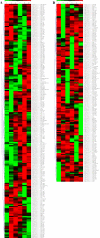Meta-analysis of Drosophila circadian microarray studies identifies a novel set of rhythmically expressed genes
- PMID: 17983263
- PMCID: PMC2098839
- DOI: 10.1371/journal.pcbi.0030208
Meta-analysis of Drosophila circadian microarray studies identifies a novel set of rhythmically expressed genes
Abstract
Five independent groups have reported microarray studies that identify dozens of rhythmically expressed genes in the fruit fly Drosophila melanogaster. Limited overlap among the lists of discovered genes makes it difficult to determine which, if any, exhibit truly rhythmic patterns of expression. We reanalyzed data from all five reports and found two sources for the observed discrepancies, the use of different expression pattern detection algorithms and underlying variation among the datasets. To improve upon the methods originally employed, we developed a new analysis that involves compilation of all existing data, application of identical transformation and standardization procedures followed by ANOVA-based statistical prescreening, and three separate classes of post hoc analysis: cross-correlation to various cycling waveforms, autocorrelation, and a previously described fast Fourier transform-based technique. Permutation-based statistical tests were used to derive significance measures for all post hoc tests. We find application of our method, most significantly the ANOVA prescreening procedure, significantly reduces the false discovery rate relative to that observed among the results of the original five reports while maintaining desirable statistical power. We identify a set of 81 cycling transcripts previously found in one or more of the original reports as well as a novel set of 133 transcripts not found in any of the original studies. We introduce a novel analysis method that compensates for variability observed among the original five Drosophila circadian array reports. Based on the statistical fidelity of our meta-analysis results, and the results of our initial validation experiments (quantitative RT-PCR), we predict many of our newly found genes to be bona fide cyclers, and suggest that they may lead to new insights into the pathways through which clock mechanisms regulate behavioral rhythms.
Conflict of interest statement
Figures




References
-
- Claridge-Chang A, Wijnen H, Naef F, Boothroyd C, Rajewsky N, et al. Circadian regulation of gene expression systems in the Drosophila head. Neuron. 2001;32:657–671. - PubMed
-
- Wijnen H, Naef F, Young MW. Molecular and statistical tools for circadian transcript profiling. Methods Enzymol. 2005;393:341–365. - PubMed
-
- Wijnen H, Naef F, Boothroyd C, Claridge-Chang A, Young MW. Control of daily transcript oscillations in Drosophila by light and the circadian clock. PLoS Genet. 2006;2:e39. doi: 10.1371/journal.pgen.0020039. - DOI - PMC - PubMed
-
- Allada R. Circadian clocks: A tale of two feedback loops. Cell. 2003;112:284–286. - PubMed
-
- Allada R, Emery P, Takahashi JS, Rosbash M. Stopping time: The genetics of fly and mouse circadian clocks. Annu Rev Neurosci. 2001;24:1091–1119. - PubMed
Publication types
MeSH terms
Substances
LinkOut - more resources
Full Text Sources
Molecular Biology Databases

